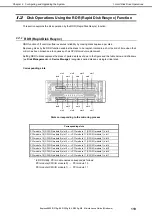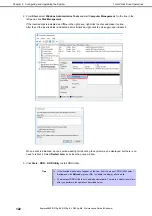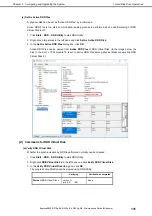
1. Hard Disk Drive Operations
Express5800/R310g-E4, R320g-E4, R320g-M4 Maintenance Guide (Windows)
120
Chapter 2 Configuring and Upgrading the System
Cautions for using the RDR function as follows:
Log on to a built-in administrator account.
Be sure to specify RDR to all disks inserted into the built-in slots and make duplex settings.
For a disk to set RDR, use a new or physically formatted disk which has the same capacity.
For a disk to be inserted, use a new or physically formatted disk which has the ame capacity as the
synchronization source. If such a disk is not used, disks are not duplexed successfully.
As for physical format, see
Chapter 3 (3.3 Physical Formatting of the Hard Disk Drive)
.
Create a data disk partition after configuring the RDR. If you create a data disk partition before configuring
the RDR, the partition’s drive letters may be deleted when the RDR is configured. Change drive letters see
Chapter 2 (2. Change Drive Letter)
.
Disk may become offline when RDR is set. In this case, use
Disk Management
to make it online.
When setting RDR, there are cases a FAT volume whose name is FTSERVER, is created with the size of
1MB, then it is displayed on
Disk Management
. And, the drive character is sometimes assigned to this
volume. There is no problem with deleting that volume. After converting a disk with RDR setting to a
dynamic disk, when this volume exists and you are going to make a new volume on the dynamic disk, the
following error message is displayed and you can't make a volume.
Please perform following procedure to make a volume on the dynamic disk.
1. Right-click the left bottom of screen, and click
Disk Management
from the menu displayed.
2. Convert a target disk with RDR setting to a dynamic disk.
3. Right-click and delete a FAT volume, whose name is FTSERVER and whose Type is Dynamic, with the
size of 1MB in displayed volumes on the upper row of the screen.
(Refer to red frame in the following
example.) If some volumes exist, delete those all.
4. By operation of 3, it returns to a basic disk, so convert to a dynamic disk once again.
5.
Make a new volume.






























